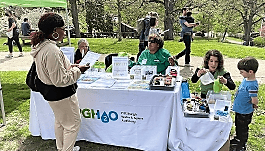Using customer engagement to drive success for water infrastructure projects
February 22, 2023

AWWA Articles
Using customer engagement to drive success for water infrastructure projects
 This is an excerpt from an article by Rebecca Zito, senior manager of public affairs for Pittsburgh Water and Sewer authority, that was recently published in Water Innovations Top 10 Trends for 2023 by Water Online.
This is an excerpt from an article by Rebecca Zito, senior manager of public affairs for Pittsburgh Water and Sewer authority, that was recently published in Water Innovations Top 10 Trends for 2023 by Water Online.
Water utilities have learned that both public and stakeholder engagement play major roles in the long-term success of infrastructure projects. Investing in the right technology tools and services to communicate information can help secure public support and reduce (or eliminate) community resistance in the long run.
Ongoing customer engagement during infrastructure projects requires a multifaceted and well-executed approach. It’s imperative to remain transparent, prioritize continuous communication, and meet customers where they are by implementing the following strategies.
Involve the community
 Pittsburgh Water and Sewer Authority (PWSA) currently is investing in a massive water, sewage and stormwater infrastructure update that’s part of a $1.4 billion improvement program extending into 2026. Many of its large-scale pumping and water distribution facilities will be rebuilt and modernized. (Pictured left, a PWSA-sponsored booth at an Arbor Day event.)
Pittsburgh Water and Sewer Authority (PWSA) currently is investing in a massive water, sewage and stormwater infrastructure update that’s part of a $1.4 billion improvement program extending into 2026. Many of its large-scale pumping and water distribution facilities will be rebuilt and modernized. (Pictured left, a PWSA-sponsored booth at an Arbor Day event.)
During the yearslong undertaking, the utility is using different techniques including social media posts and community meetings to include customers in the discussion and keep them informed about the project status and impacts.
During in-person meetings, community members are asked to provide input on different design stages. Participants are directed to PWSA’s website, which lists all construction projects. PWSA also is providing residents within a project area with door hangers and brochures to keep them updated.
Prioritize geo-targeting
Because every community is different, PWSA uses a process to target specific individuals, households and communities. This can involve these steps:
- Use a geographic information system (GIS) to define the project area
- Identify the residents and businesses located in the defined geographic region
- Schedule a community meeting to inform residents about what’s happening and encourage them to ask questions
- Contact community ambassadors familiar with the neighborhoods and communities and encourage local residents to share information with their neighbors, which adds a more personal dimension
- Update residents and businesses via emails, automated phone calls and letters about each stage of water infrastructure projects
- Establish a website project page and update it with in-depth information about project status, such as construction impact and estimated length of time
- Post information on social media to expand project awareness and updated information
- Continue the conversation on social media and during in-person meetings
Encourage continuous communication
 Ongoing construction can be noisy and disruptive, and no one likes having it in their neighborhood. However, it can initiate a two-way conversation between water utilities and communities. (Pictured right, PWSA workers removing a lead service line.)
Ongoing construction can be noisy and disruptive, and no one likes having it in their neighborhood. However, it can initiate a two-way conversation between water utilities and communities. (Pictured right, PWSA workers removing a lead service line.)
It’s helpful to establish a point of contact during the initial stages of an infrastructure project. A communications project manager can field calls and complaints from residents, answer questions, and offer as much information as possible, such as how long the project will last and what are its long-term benefits. This information can help offset the annoyance of short-term inconveniences.
PWSA has found opportunities for community engagement when incorporating green infrastructure such as rain gardens, vegetation and permeable pavers into public spaces. Stormwater projects tend to be more visible to residents because they often occur on the surface, creating an opportunity for ongoing dialogue about other neighborhood needs.
Engage and involve community partners
Outside of construction and infrastructure projects, forming advisory groups with community stakeholders and partners is effective when implementing programs that are new or will affect a large number of customers.
Bringing together a diverse group of engage community representatives is helpful for talking through potential challenges and shaping a program before its launch. Some will meet for just a short period, while others may be ongoing to review and adapt a program as needs or expectations change.
The two-way dialogue with advisory groups builds awareness and understanding of the challenges that both the utility and residents may face. This builds trust and establishes informed advocates for a utility.
The silent utility provider has become a thing of the past. Transparency, frequent communication and awareness are critical factors in the success of infrastructure projects.
Advertisement